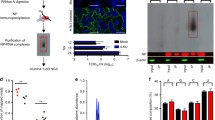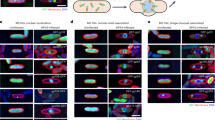Abstract
The electron microscopic study of DNA-protein complexes can yield valuable information that is often not easily available by other methods. In this article we give a number of examples that were chosen to illustrate the utility of electron microscopy. Along with the strategy used are protocols that allow such experiments to be carried out.
The first example employs the following strategy. Points of close proximity between nucleic acid and protein within a bacteriophage or virus are made permanent by crosslinking. Bacteriophage or virus are then partially disrupted so that individual components can be visualized. With bacteriophages, such experiments show which DNA end first enters the host on infection and therefore can in principle indicate which phage genes would be first available for transcription. This type of experiment can also show which DNA end is first to be encapsulated during formation of the bacteriophage. Information on direction of encapsulation and indirectly, direction of replication of the rolling circles that lead to concatermeric DNA to be encapsulated, can also be derived. Such experiments can additionally accuratel define the degree of DNA permutation, if present, within a bacteriophage population.
Finally, examples are shown for in vitro reactions involving DNA, RecA, RecO, RecF, RecR, and SSB that lead to a further understanding of recombinational repair. Additionally antibody-gold labeling is used to locate various proteins in such complexes.
Similar content being viewed by others
References
Kleinschmidt, A., Lang, D., Jacherts, D., and Zahn, R. (1962) Darstellung und Längenmessungen des gesamten Desoxyribonucleinsäure-inhaltes von T2-bakteriophagen. Biochim. Biophys. Acta 61, 857–864.
Inman, R. B. and Schnos, M. (1970) Partial denaturation of thymine-and 5-bromouracil-containing 1 DNA in alkali. J. Mol. Biol. 49, 93–98.
Chattoraj, D. and Inman, R. B. (1974) Location of DNA ends in P2, 186, P2, and lambda bacteriophage heads. J. Mol. Biol. 87, 11–22.
Inman, R. B., Schnos, M., and Howe, M. (1976) Location of the “variable end” of Mu DNA within the bacteriophage particle. Virology 72, 393–401.
Shan, Q., Bork, J. M., Webb, B. L., Inman, R. B., and Cox, M. M. (1997) RecA protein filaments: end-dependent dissociation from ssDNA and stabilization by RecO and RecR protein. J. Mol. Biol. 265, 519–540.
Webb, B. L., Cox, M. M., and Inman, R. B. (1997) Recombinational DNA repair: the RecF and RecR proteins limit the extension of RecA filaments beyond single-strand DNA gaps. Gene 91, 1–20.
Author information
Authors and Affiliations
Corresponding author
Rights and permissions
About this article
Cite this article
Schnos, M., Inman, R.B. New insights into protein-DNA interactions obtained by electron microscopy. Mol Biotechnol 16, 77–86 (2000). https://doi.org/10.1385/MB:16:1:77
Issue Date:
DOI: https://doi.org/10.1385/MB:16:1:77




